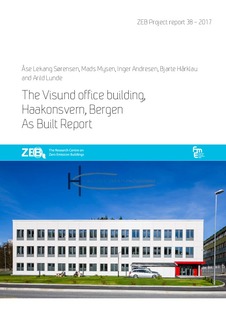| dc.description.abstract | The Visund office building is a pilot project within the Research Centre on Zero Emission Buildings (ZEB) in Norway. The building has 2031 m2 of heated floor area and is located at Haakonsvern, about 15 km from the centre of Bergen, Norway. The building is owned by the Norwegian Defence Estates Agency (Forsvarsbygg) and the main contractor was Veidekke. The building has been in operation since January 2016.
The design aimed at meeting the ZEB-criterion of net zero emission balance, excluding energy for appliances. The compact and simple building form has been carefully planned, giving an energy efficient and airtight building envelope with good daylight conditions. Heating and cooling is provided by a local seawater-based heat pump. The temperature, as well as the ventilation and lighting systems are demand controlled. A photovoltaic system installed on the roof is generating electricity.
The energy performance has been closely monitored and the energy measurements during the first year corresponds well with the predicted energy use and required indoor climate performance. Energy need for lighting is an exception and was higher than predicted in 2016. Improvements have been made during the year to reduce this energy post. The indoor temperature has been higher than estimated in the calculations, with an average of 22.9°C in 2016, compared with estimated 21°C. The energy generation from the PV plant corresponds well to the predicted energy generation.
To satisfy the ZEB-goal, the PV plant has to generate as much electricity as the energy delivered to the building, except the energy needed for appliances. In 2016, the delivered energy during the year was 45.1 kWh/m² and energy generation from the PV plant was 27.5 kWh/m², giving a net delivered energy of 17.6 kWh/m²; 4.1 kWh/m² more than the energy need for appliances during the same year. The ZEBgoal was therefore not completely achieved during the first year of operation. Delivered energy was 7% higher than the predicted value, achieving the contract requirement of maximum 20%.
Given that this was the initial operational year, with a number of improvements, it seems likely that the Visund office building later will achieve the ZEB-goal of net zero emission balance for building operation during a year.
The Visund office building project shows that it is possible to build a net zero emission office building in Bergen with commercially available products and traditional design and construction process. A high focus on clear and shared goals, contract based economic incentives, robust building design and technology choices, energy monitoring, and follow-up measures have been key factors to achieve the goals. | nb_NO |
